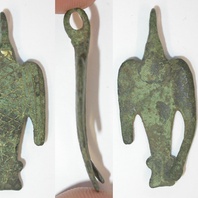
Viking Objects
Bird Pendant (DENO-55AE35)
A pendant of similar shape although with different decoration is dated to the second half of the ninth century from Yaroslavl, Russia. The bird symbol, very similar to the one depicted on this pendant, was used by the Rurik dynasty which had started the conquest of Slavic lands in the mid-ninth century and later formed the polity of Rus’. With some exceptions, pendants were generally worn by women as an accessory to Scandinavian dress.
Read More
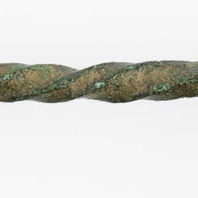
Viking Objects
Copper-Alloy Ear Spoon (CM_1849_2008)
This copper-alloy ear spoon has a spiral twisted body with a small rounded head. It was found at Torksey, Lincolnshire. Ear scoops (also known as ear spoons) were used to clean out ear wax. They are very common finds on Viking Age sites, suggesting that people took this aspect of personal hygiene very seriously.
Read More
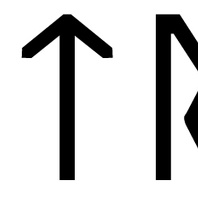
Viking Names
Eindridi
The Old Norse male name Eindriði is mainly found in Norway. It is the first element of Enderby (now divided into Bag Enderby, Mavis Enderby and Wood Enderby) and possibly Anderby, both in Lincolnshire. There is also an Enderby in Leicestershire.
Read More
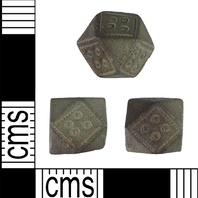
Viking Objects
Polyhedral Weight (LIN-752A9C)
This copper-alloy weight is of a type common within the Scandinavian diaspora. This example has fourteen sides and four dots on each of the rectangular sides. These weights were adopted by the Vikings from Middle Eastern examples and appear to have become a de facto weight standard for traders. Weights are an important form of evidence for Viking Age commerce and the use of standards across the different economic systems within which Vikings were integrated. Many of the weights discovered, particularly ones in Ireland and those of Arabic type, suggest that a standardized system of weights existed in some areas. These standard weights, alongside standard values of silver, are what allowed the bullion economy of Viking occupied areas to function. A bullion economy was a barter economy that relied on the exchange of set amounts of precious metal in various forms, such as arm-rings or coins, for tradable goods, such as food or textiles. Each merchant would have brought their own set of weights and scales to a transaction to make sure that the trade was conducted fairly.
Read More
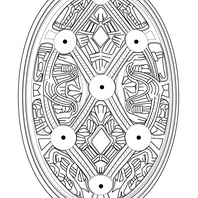
Viking Designs
Drawing of Oval Brooch
Drawing of an oval brooch based on examples for Adwick le Street, Doncaster. Brooches were a typical part of female dress. Scandinavian brooches came in a variety of sizes and shapes which included disc, trefoil, lozenge, equal-armed, and oval shapes. The different brooch types served a variety of functions in Scandinavian female dress with oval brooches typically being used as shoulder clasps for apron-type dresses and the rest being used to secure an outer garment to an inner shift. Anglo-Saxon brooches do not match this diversity of form with large disc brooches being typical of ninth century dress styles with smaller ones becoming more popular in the later ninth and tenth centuries. However, since disc brooches were used by both Anglo-Saxon and Scandinavian women they are distinguished by their morphology. Scandinavian brooches were typically domed with a hollow back while Anglo-Saxon brooches were usually flat. Moreover, Anglo-Saxon brooches were worn singly without accompanying accessories.
Read More
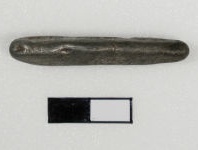
Viking Objects
Silver Ingot (2010-195)
Ingots of this size and shape were used as a convenient way to store and carry silver in the Viking Age. They might be cut up into pieces (hacksilver) to be used as bullion for payments, or be processed into jewellery. Analysis of silver ingots from this period shows that many were made from silver mined in the Middle East. This silver was probably originally used to mint Arabic dirhams (a type of coin) but was melted down by the Vikings to make it more easily portable.
Read More
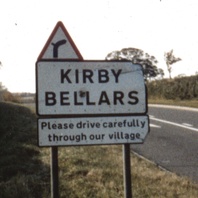
Viking Names
Kirby Bellars
Kirby Bellars, in the Framland Hundred of Leicestershire, comes from the Old Norse elements kirkja ‘church’ and by ‘farm, settlement’. The affix Bellars is derived from the personal surname Beler. Hamo Beler held the manor in 1166 and it remained in the family as late as 1361.
Read More
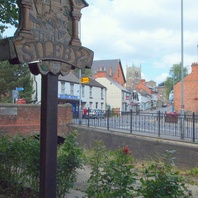
Viking Names
Sileby
Sileby, in the East Goscote Hundred of Leicestershire, comes from the Old Norse male personal name Sigulfr and the Old Norse element by ‘a farmstead, a village’.
Read More
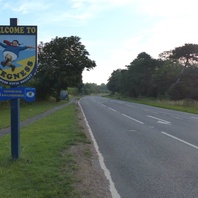
Item
Skegness
Skegness, in the Candleshoe Wapentake of Lincolnshire, is a Scandinavian compound, but the meaning of the place-name is uncertain. One suggestion is ‘Skeggi’s headland’ from the Old Norse male personal name Skeggi and the Old Norse element nes ‘ a ness, a headland, a promontory’. More likely, the first element could be the Old Norse element skegg ‘beard’, ‘something jutting out’, which is related to the verb skaga and the topographical term skagi ‘promontory’. This Old Norse appellative is probably found in the two Skegby place-names in Nottinghamshire.
Read More
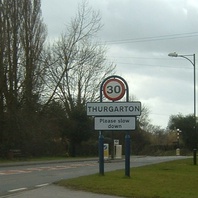
Viking Names
Thurgarton
Thurgarton, in the Thurgarton Wapentake of Nottinghamshire, comes from the Old Norse male personal name Þorgeirr (though in an anglicised form Þurgar) and the Old English element tun ‘farm, settlement’, and is thus a hybrid name.
Read More
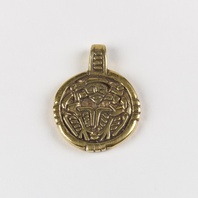
Viking Objects
Reproduction Pendant with an Odin Motif
This reproduction of a cast silver, gilded pendant featuring an image of a one-eyed figure with two birds has been interpreted as Odin and his two ravens, Huginn and Muninn. The original pendant was found at Winteringham, Lincolnshire. There are a number of close parallels which establish the wide currency of this subject group. These include numerous examples from Russia and two from Sweden, including some with silver gilding. A silver pendant with a related, but distinct design is known from Sjælland, Denmark.
